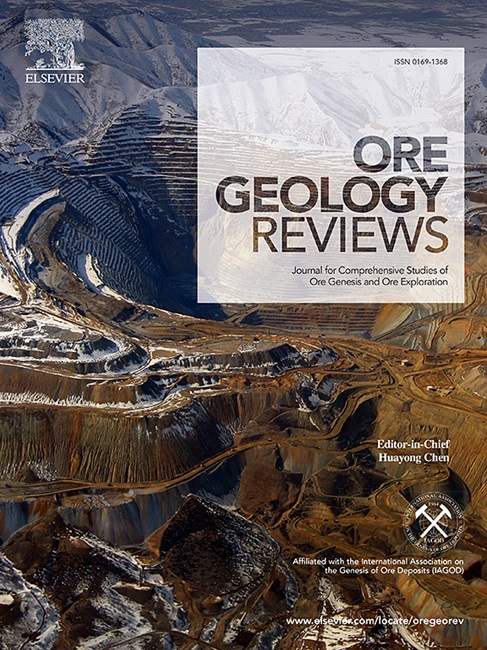Enhanced solubility of gold in crude oil at high temperatures: new insights into ore genesis
IF 3.6
2区 地球科学
Q1 GEOLOGY
引用次数: 0
Abstract
Gold’s exceptional conductivity and corrosion resistance make it indispensable in various industries, yet its transport and deposition mechanisms remain a subject of exploration. While hydrothermal fluids are traditionally considered the primary medium for gold mobilization, recent evidence suggests hydrocarbons could also transport metals under specific conditions. This study investigates the solubility of gold in crude oil with varying compositions at temperatures up to 250 °C, focusing on the role of sulfur (S) content and Total Acid Number (TAN). Crude oils from the Bohai Bay Basin, China, were exposed to gold wires for durations of up to 30 days in a quartz tube and titanium alloy tube setup. Results reveal that gold solubility increases with temperature and time, with maximum concentrations observed at 250 °C. The highest solubility (19.8 ppm) was observed in the oil sample with the highest sulfur (S) and Total Acid Number (TAN) content. Furthermore, X-ray Photoelectron Spectroscopy (XPS) analysis indicates that gold (Au) exhibits a strong affinity for carbon-, oxygen-, and sulfur-containing compounds in crude oil, suggesting the formation of thiol or organic acetate complexes. Post-experiment SEM analysis revealed significant surface erosion of gold wires, supporting the hypothesis of enhanced gold dissolution in hydrocarbons at elevated temperatures. These findings challenge conventional ore genesis models by highlighting hydrocarbons as a potential medium for metal transport in organic-rich and petroleum-bearing environments, offering new perspectives for understanding hydrocarbon-driven gold mineralization.

高温下金在原油中的溶解度增强:对矿石成因的新认识
黄金卓越的导电性和耐腐蚀性使其在各种工业中不可或缺,但其运输和沉积机制仍是探索的主题。传统上,热液流体被认为是调动黄金的主要介质,但最近的证据表明,碳氢化合物也可以在特定条件下运输金属。本研究研究了黄金在温度高达250℃的不同成分原油中的溶解度,重点研究了硫(S)含量和总酸值(TAN)的作用。来自中国渤海湾盆地的原油在石英管和钛合金管装置中与金线接触长达30天。结果表明,金的溶解度随温度和时间的增加而增加,在250℃时达到最大浓度。硫(S)和总酸值(TAN)含量最高的油样溶解度最高(19.8 ppm)。此外,x射线光电子能谱(XPS)分析表明,金(Au)对原油中的含碳、含氧和含硫化合物具有很强的亲和力,表明形成了硫醇或有机醋酸酯配合物。实验后的扫描电镜分析显示,金丝表面有明显的侵蚀,支持了高温下金在碳氢化合物中溶解增强的假设。这些发现挑战了传统的成矿模型,强调了碳氢化合物是富有机质和含油气环境中金属输运的潜在介质,为理解碳氢化合物驱动的金矿化提供了新的视角。
本文章由计算机程序翻译,如有差异,请以英文原文为准。
求助全文
约1分钟内获得全文
求助全文
来源期刊

Ore Geology Reviews
地学-地质学
CiteScore
6.50
自引率
27.30%
发文量
546
审稿时长
22.9 weeks
期刊介绍:
Ore Geology Reviews aims to familiarize all earth scientists with recent advances in a number of interconnected disciplines related to the study of, and search for, ore deposits. The reviews range from brief to longer contributions, but the journal preferentially publishes manuscripts that fill the niche between the commonly shorter journal articles and the comprehensive book coverages, and thus has a special appeal to many authors and readers.
 求助内容:
求助内容: 应助结果提醒方式:
应助结果提醒方式:


